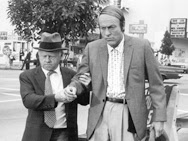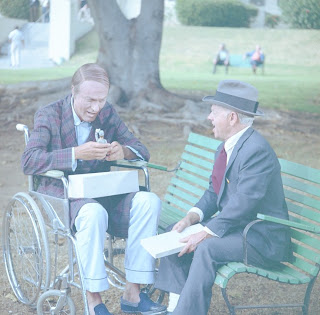 |
| the King of all Media |
Over the years I've had the opportunity to draw one of my all time favorite broadcasters, the one and only
King of All Media, Howard Stern, many times. Howard himself hired me on several occasions to draw him for his old WOR TV show... (including an illustration of Howard diapering a geriatric Henny Youngman... sadly, I have no record of the drawing). I also illustrated his two bestselling books,
Private Parts &
Miss America, and created the character designs for an animated TV show about his teenage years that was in development several years ago which unfortunately never came to pass (See below).
Howard and I seem to have a mutual appreciation for one another's work, as he's enthusiastically discussed my art many times over the years on the air, beginning in 1991 by praising my and my brother Josh's book "Warts & All", and has also sited me numerous times as his "favorite artist". An honor indeed.
Howard affirms that Drew Friedman is better than Picasso:
http://www.youtube.com/watch?v=svxtON1eEl4
Howard feels that Drew Friedman's art should be worth $300 billion:
http://www.youtube.com/watch?v=R22WlcDk7eE
When I was (briefly) a member of the illustration online group "Drawger", fellow member and Howard Stern fan Tim O'Brien suggested that I create a post featuring my Howard Stern illustrations; which I did. My Drawger account was deactivated when I left the group, so here (again) is a far more expansive selection (but not all) of my Howard Stern illustrations covering the last 20 years, including some examples that have not been seen before.
Ba Ba... Booey.
 |
| Future Howard Stern Movies, for SPIN magazine/1992, created after HS started speculating about making his film debut, reprinted in his book Private Parts (click to enlarge) |
 |
| A lovingly disgusting and vile comic strip created for HS's book Private Parts, based on a radio bit written by Howard and Fred Norris (FYI: "NAMBLA"-- "North American Man-Boy Love Association"... Oy Vey) K. Bidus broke the radio script down into this comic strip format. |
 |
Howard Stern for Governor, Al Sharpton for Senator, kissing an unhappy baby.
From The New Yorker/1994, concept by K. Bidus. This (with a color overlay) was originally scheduled to be a New Yorker cover, until the editor Tina Brown had last minute-second/third thoughts, and it wound up as an interior page. Also reprinted in HS's second book "Miss America" leading off his chapter about running for New York Governor |
 |
Newsweek/1996,
for an article about celebrated people with just one sibling (including Bill Clinton) |
 |
1994: For HS's book Miss America, Howard wanted a chapter-opening illustration depicting his personal agony and torment: Here he is secluded in his basement/dungeon attempting to write his new book on the computer (and watch porn), as the demands of his family members and show staff weigh on his mind
"The Path of the Warrior"
For the book Miss America, with text provided by co-author Larry "Ratso" Sloman, I created this 4 page "game board" spread depicting HS's path to inevitable conquest and domination of the radio business.
lettering by Phil Felix
|
 |
I've drawn HS several times for MAD magazine over the years, including for this 2 pg spread from 1995 (click to enlarge)
"Ladies' Man", New York magazine/1997, posed with his wife Allison, for an article about how HS was attempting to show his sensitive side in his newly released film "Private Parts" |
 |
"Black Rock's New Look", from New York magazine/1998. Howard's Infinity radio boss Mel Karmazin was just hired to run CBS, so I posed him as King Kong (a cliched image, yes, but I'm pleased with the result), atop the CBS building known as Black Rock, clutching his "beauty" (a relaxed Howard Stern), as fellow CBS employes Don Imus and Dan Rather vie for Mel's attention
art director, Josh Mckibble |
 |
| For the cover of the NY Observer/2004, at the height of the war in Iraq, and HS's unrelenting radio attacks on George W. Bush, the two of them embraced in a dance. The original word balloon read: "Eat Me" but was changed at the last moment (family newspaper) |
 |
"Shock Waves", 2004/Entertainment Weekly
for an article about HS's move to satellite radio |
 |
Howard Stern, the Teenage years
the TV show that never was...
With the huge success of Chris Rock's TV sitcom "Everybody Hates Chris" depicting Chris's boyhood years, Spike TV signed a deal with HS in 2004 to develop an animated show about Howard's early years entitled "Howard Stern, the Teenage Years", and signed the young actor Michael Cera (Juno) on to voice the young Howard. Some character designs and animation was prepared for Howard to view but he was completely unhappy with it, so he called me and asked if I could do several character sketches, (he also told me he considered asking Robert Crumb as well, whose work he also admires), mainly of himself, his parents and his older sister Ellen. He asked me to basically try to make him look like a "big-nosed, pimple-faced, sad, demented chicken" |
 |
Young Howard in perennial "shell-shock", his father Ben and sister ("the favorite") Ellen
HS thought my sketches nailed it, but the brilliant powers that be at Spike TV told him my designs would be too expensive for them to animate, which Howard was not pleased to hear, so he decided to scrap the whole series if he couldn't have the animation look the way he wanted. Ah well, that's show biz... |
 |
| two "more cartoony" teenage Howards... |
 |
| in "perennial shell-shock" |
 |
| After HS pulled the plug on the show, he sent me this note |
 |
GQ magazine/2006
On the occasion of the HS show moving to Sirius satellite radio, GQ presented a "Howard Stern Show Primer" for the uninitiated
Clockwise from bottom left: Horse-toothed jackass Producer Gary Del'abate, writer & jack of all trades Fred Norris, lilting "High Pitch" Eric, hair-extended co-host Robin Quivers, "Beetlejuice", fat comedian/show sidekick Artie Lange, and center, the King of all Media.
art director: Thomas Alberty. |
 |
| In 2007, with a then current "Zombie Craze" at hand, the Topps bubblegum company released a card series called "Hollywood Zombies". I painted several of them, including this "HS among his worshiping, sycophant disciples" image. Concept by Frank Santopadre. |
 |
Book cover from 2009 via Harper Collins, an anthology of 20 years of the New York Observer. HS, top left
portrait of Howard Stern for "Drew Friedman's Chosen People" (2017, Fantagraphics)
Special thanks to K. Bidus, Liz Belmont and Lorrie Davis |








































































